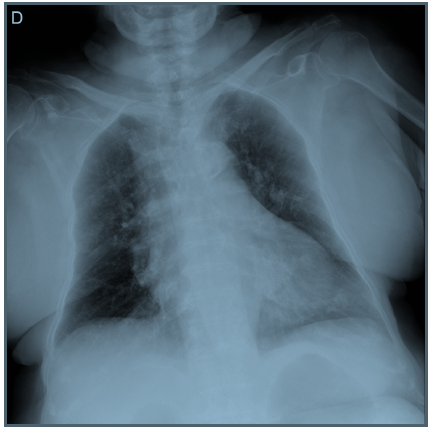Introduction
Caseous calcification of the mitral annulus is an underdiagnosed disease, which can be associated with aging and cardiovascular disease: hypertension, diabetes, dyslipidemia
Case report
We present a case of an 89 year-old woman, with previous history of hypertension, who was admitted to the emergency department due to asthenia and fever for 1 week. The physical examination was only remarkable for the presence of systolic heart murmur at mitral location. A chest X-Ray revealed a large, ovoid, dense structure overlying the cardiac silhouette (Fig. 1). Transthoracic echocardiography was performed with a hand-held ultrasound device (VscanTM), on apical four-chamber view, a large (3.04 × 3.30 cm), round, echodense structure along the posterior mitral annulus, with central echolucency and mild acoustic shadow was noticed, associated with moderate regurgitation and stenosis (B-mode in video 2A, color Doppler in 2B), with conserved ventricular systolic function. Laboratory workup showed mildly elevated inflammatory markers, CRP 48 mg/dL [range: 0-5], white blood cell count 11000/ µL [range: 3000-10000], renal function showed an elevation of creatinine 115 µmol/L [range: 49- 92] and urinalysis revealed glucosuria, nitrate positive and 3-6 WBC/HPF [range: 0-3], which was compatible with urinary tract infection. Ceftriaxone was empirically started, and her clinical condition gradually improved. At that time, urine culture reported a heavy growth of multi-drug sensitive Escherichia coli strain.
The patient’s caseous calcification was managed conservatively, and on routine follow-up, type 2 diabetes was diagnosed, achieving good glycemic control with metformin.
Discussion
Caseous calcification of the mitral annulus is an underdiagnosed variant of mitral annular calcification due to its often-asymptomatic course.2 As we see, can be incidentally detected on chest radiographs of the elderly, related with aging, hypertension, diabetes, dyslipemia and end-stage renal disease, can also be associated with cardiovascular disease (stroke, coronary disease and atrial fibrillation). Though, the explicit pathophysiology is not known.1
Nonetheless, when detected, a careful assessment of potential cardiovascular risk factors should be performed, and not misdiagnose it as pneumonia, pulmonary nodule, myocardial abscess, tumor or thrombus. The often-asymptomatic clinical course, in addition to the characteristic large, round, well-defined borders, echodense with central areas of echolucency, and typically posterior mitral leaflet site help distinguish it from these other diseases.4,5
Due to its benign and chronic course, conservative monitoring is the main recommendation in the long-term management of these patients, while surgery should be reserved only for cases with severe valvular dysfunction. For this purpose, hand-held transthoracic echocardiography, performed at bedside, is a very useful tool to avoid unnecessary investigations.6
Ethics
All authors meet the criteria for authorship stated in the Uniform Requirements for Manuscripts Submitted to Biomedical Journals. All authors have contributed equally to this work. This work has not been supported by public grants or financial support. No sources of funding were used to assist in the preparation of this case report. Each author certifies that he has no commercial associations that might pose a conflict of interest in connection with the submitted article. We certify that the reporting of this case was conducted in conformity with ethical principles of our institution. Our figures have not been previously published and reproduced from another source.















